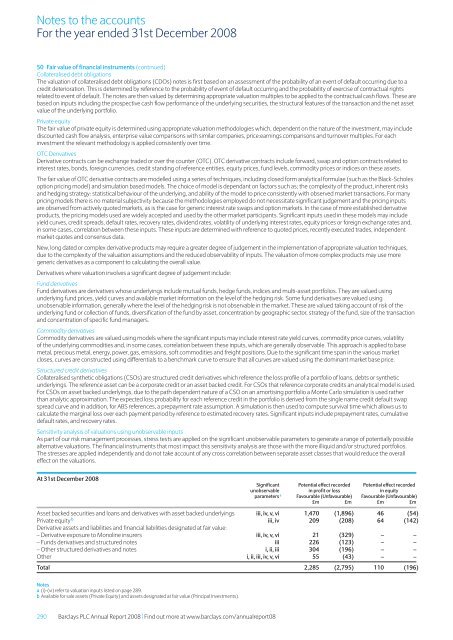Barclays plc - Annual Report 2008 - Financial statements - The Group
Barclays plc - Annual Report 2008 - Financial statements - The Group
Barclays plc - Annual Report 2008 - Financial statements - The Group
You also want an ePaper? Increase the reach of your titles
YUMPU automatically turns print PDFs into web optimized ePapers that Google loves.
Notes to the accounts<br />
For the year ended 31st December <strong>2008</strong><br />
50 Fair value of financial instruments (continued)<br />
Collateralised debt obligations<br />
<strong>The</strong> valuation of collateralised debt obligations (CDOs) notes is first based on an assessment of the probability of an event of default occurring due to a<br />
credit deterioration. This is determined by reference to the probability of event of default occurring and the probability of exercise of contractual rights<br />
related to event of default. <strong>The</strong> notes are then valued by determining appropriate valuation multiples to be applied to the contractual cash flows. <strong>The</strong>se are<br />
based on inputs including the prospective cash flow performance of the underlying securities, the structural features of the transaction and the net asset<br />
value of the underlying portfolio.<br />
Private equity<br />
<strong>The</strong> fair value of private equity is determined using appropriate valuation methodologies which, dependent on the nature of the investment, may include<br />
discounted cash flow analysis, enterprise value comparisons with similar companies, price:earnings comparisons and turnover multiples. For each<br />
investment the relevant methodology is applied consistently over time.<br />
OTC Derivatives<br />
Derivative contracts can be exchange traded or over the counter (OTC). OTC derivative contracts include forward, swap and option contracts related to<br />
interest rates, bonds, foreign currencies, credit standing of reference entities, equity prices, fund levels, commodity prices or indices on these assets.<br />
<strong>The</strong> fair value of OTC derivative contracts are modelled using a series of techniques, including closed form analytical formulae (such as the Black-Scholes<br />
option pricing model) and simulation based models. <strong>The</strong> choice of model is dependant on factors such as; the complexity of the product, inherent risks<br />
and hedging strategy: statistical behaviour of the underlying, and ability of the model to price consistently with observed market transactions. For many<br />
pricing models there is no material subjectivity because the methodologies employed do not necessitate significant judgement and the pricing inputs<br />
are observed from actively quoted markets, as is the case for generic interest rate swaps and option markets. In the case of more established derivative<br />
products, the pricing models used are widely accepted and used by the other market participants. Significant inputs used in these models may include<br />
yield curves, credit spreads, default rates, recovery rates, dividend rates, volatility of underlying interest rates, equity prices or foreign exchange rates and,<br />
in some cases, correlation between these inputs. <strong>The</strong>se inputs are determined with reference to quoted prices, recently executed trades, independent<br />
market quotes and consensus data.<br />
New, long dated or complex derivative products may require a greater degree of judgement in the implementation of appropriate valuation techniques,<br />
due to the complexity of the valuation assumptions and the reduced observability of inputs. <strong>The</strong> valuation of more complex products may use more<br />
generic derivatives as a component to calculating the overall value.<br />
Derivatives where valuation involves a significant degree of judgement include:<br />
Fund derivatives<br />
Fund derivatives are derivatives whose underlyings include mutual funds, hedge funds, indices and multi-asset portfolios. <strong>The</strong>y are valued using<br />
underlying fund prices, yield curves and available market information on the level of the hedging risk. Some fund derivatives are valued using<br />
unobservable information, generally where the level of the hedging risk is not observable in the market. <strong>The</strong>se are valued taking account of risk of the<br />
underlying fund or collection of funds, diversification of the fund by asset, concentration by geographic sector, strategy of the fund, size of the transaction<br />
and concentration of specific fund managers.<br />
Commodity derivatives<br />
Commodity derivatives are valued using models where the significant inputs may include interest rate yield curves, commodity price curves, volatility<br />
of the underlying commodities and, in some cases, correlation between these inputs, which are generally observable. This approach is applied to base<br />
metal, precious metal, energy, power, gas, emissions, soft commodities and freight positions. Due to the significant time span in the various market<br />
closes, curves are constructed using differentials to a benchmark curve to ensure that all curves are valued using the dominant market base price.<br />
Structured credit derivatives<br />
Collateralised synthetic obligations (CSOs) are structured credit derivatives which reference the loss profile of a portfolio of loans, debts or synthetic<br />
underlyings. <strong>The</strong> reference asset can be a corporate credit or an asset backed credit. For CSOs that reference corporate credits an analytical model is used.<br />
For CSOs on asset backed underlyings, due to the path dependent nature of a CSO on an amortising portfolio a Monte Carlo simulation is used rather<br />
than analytic approximation. <strong>The</strong> expected loss probability for each reference credit in the portfolio is derived from the single name credit default swap<br />
spread curve and in addition, for ABS references, a prepayment rate assumption. A simulation is then used to compute survival time which allows us to<br />
calculate the marginal loss over each payment period by reference to estimated recovery rates. Significant inputs include prepayment rates, cumulative<br />
default rates, and recovery rates.<br />
Sensitivity analysis of valuations using unobservable inputs<br />
As part of our risk management processes, stress tests are applied on the significant unobservable parameters to generate a range of potentially possible<br />
alternative valuations. <strong>The</strong> financial instruments that most impact this sensitivity analysis are those with the more illiquid and/or structured portfolios.<br />
<strong>The</strong> stresses are applied independently and do not take account of any cross correlation between separate asset classes that would reduce the overall<br />
effect on the valuations.<br />
At 31st December <strong>2008</strong><br />
Significant Potential effect recorded Potential effect recorded<br />
unobservable in profit or loss in equity<br />
parameters a Favourable (Unfavourable) Favourable (Unfavourable)<br />
£m £m £m £m<br />
Asset backed securities and loans and derivatives with asset backed underlyings iii, iv, v, vi 1,470 (1,896) 46 (54)<br />
Private equity b iii, iv 209 (208) 64 (142)<br />
Derivative assets and liabilities and financial liabilities designated at fair value:<br />
– Derivative exposure to Monoline insurers iii, iv, v, vi 21 (329) – –<br />
– Funds derivatives and structured notes iii 226 (123) – –<br />
– Other structured derivatives and notes i, ii, iii 304 (196) – –<br />
Other i, ii, iii, iv, v, vi 55 (43) – –<br />
Total 2,285 (2,795) 110 (196)<br />
Notes<br />
a (i)-(vi) refer to valuation inputs listed on page 289.<br />
b Available for sale assets (Private Equity) and assets designated at fair value (Principal Investments).<br />
290 <strong>Barclays</strong> PLC <strong>Annual</strong> <strong>Report</strong> <strong>2008</strong> | Find out more at www.barclays.com/annualreport08

















